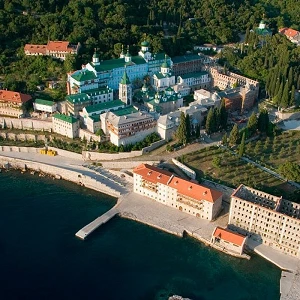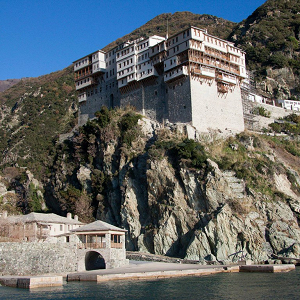Mount Athos is a unique spiritual center of Orthodoxy and at the same time a self-governed part of the Greek state. It consists of twenty sovereign Holy Monasteries, known as the Monasteries of Mount Athos, which serve as significant religious and cultural monuments. Each monastery is governed by its own internal regulation, which must be approved by the Holy Community.
The hierarchical order of the monasteries on Mount Athos is unchangeable, in accordance with Article 105 of the Greek Constitution. At the top of this hierarchy stands the Holy Monastery of Great Lavra, the first monastery founded in 963 A.D., followed, in a predetermined order, by all the others.
In detail, the hierarchy of the monasteries, along with the year they were founded and national affiliations, is as follows:
1st in hierarchy: Holy Monastery of Great Lavra – 963 A.D., Greek.
2nd in hierarchy: Holy Great Monastery of Vatopedi – between 972 and 985 A.D., Greek.
3rd in hierarchy: Holy Monastery of Iviron – 980 A.D., Greek.
4th in hierarchy: Holy Monastery of Hilandar – 1198 A.D., Serbian.
5th in hierarchy: Holy Monastery of Dionysiou – mid-14th century, Greek.
6th in hierarchy: Holy Monastery of Koutloumousiou – 11th century, Greek.
7th in hierarchy: Holy Monastery of Pantokrator – mid-14th century, Greek.
8th in hierarchy: Holy Monastery of Xeropotamou – 10th century, Greek.
9th in hierarchy: Holy Monastery of Zografou – 10th century, Bulgarian.
10th in hierarchy: Holy Monastery of Dochiari – late 10th century, Greek.
11th in hierarchy: Holy Monastery of Karakallou – 11th century, Greek.
12th in hierarchy: Holy Monastery of Philotheou – late 10th century, Greek.
13th in hierarchy: Holy Monastery of Simonopetra – 1254 A.D., Greek.
14th in hierarchy: Holy Monastery of Agios Pavlos – before 1035 A.D., Greek.
15th in hierarchy: Holy Monastery of Stavronikita – 10th century, Greek.
16th in hierarchy: Holy Monastery of Xenophontos – 998 A.D., Greek.
17th in hierarchy: Holy Monastery of Grigoriou – ca. 1310–1314 A.D., Greek.
18th in hierarchy: Holy Monastery of Esfigmenou – 5th century, Greek.
19th in hierarchy: Holy Monastery of Saint Panteleimon – 11th century, Russian.
20th in hierarchy: Holy Monastery of Konstamonitou – 11th century, Greek
Saint Pahomios, one of the Christian monasticism’s founders in the East , divided the monks’ day and night into three eight – hours periods. Eight hours of praying , eight hours of resting and eight hours of working. (deaconships and handicrafts). Nowadays, 16 centuries later, in the shade of the Holy Mount Athos, the monks who live in the cells or the monasteries, by producing as handicrafts , original products of premium quality they manage to ensure both their survival and the well preserved area they live in.

According to historical sources, around 1030, a brotherhood of Russian monks, together with their abbot, Lavrentios, settled in the Monastery of the Most Holy Theotokos of the Carpenter (identified with Skete Vogoroditsa). Over time, the number of monks grew, so in 1118 the Holy Synod of Mount Athos granted them the almost destroyed Monastery of Thessaloniki. In the middle of the 12th century the brotherhood was transferred to the Thessaloniki Monastery which was dedicated to Saint Panteleimon. In this location the brotherhood remained for about seven centuries, until 1765.

According to the tradition, the Holy Monastery of Xiropotamou was founded by Empress Pulcheria, wife of Emperor Markianus, in the year 424 AD. On the other hand, there are stories that point to Constantine VII the Porphyrogenitus or Romanos I Lekapinos as the founders of the Xiropotamou Monastery. However, according to historical sources, a more probable version for the real founder of the Monastery seems to be the monk Pavlos Xiropotaminos. The foundation of Xiropotamou Monastery dates back to the end of the 10th century by the monk Pavlos, who signed the first charter or Typikon (972 AD) of Mount Athos.

According to the tradition, the founders of Zografou Monastery are considered to be three brother monks, Moses, Aaron and John from Ahrida, who lived on Mount Athos in the 10th century. However, historical evidence testifies to another version of the establishment of the Monastery. In the first charter of Tsimiskis (972), George the Painter (in Greek, Zografos) is mentioned as the builder of the Zografou Monastery, who signs as abbot of the Monastery. The Zografou Monastery is dedicated to Saint George, as an old miraculous icon is preserved, which is one of the most important relics of the Monastery.

The Dionysios Monastery was built in the 14th century and its founder was Saint Dionysios from Korysos in Kastoria. The construction of the monastery was a laborious process for Dionysios, as there were no financial resources and means for building. In the effort of Dionysios, a great supporter and sponsor was Alexios III Komnenos, Emperor of Trebizond, motivated also by the Metropolitan of the city Theodosios, who was a fellow brother of Dionysios. Donations to the Monastery were later continued by the Emperors Palaiologos, as well as by many leaders of Moldavia. Saint Dionysios completed the construction of the Monastery in 1380 and gave it his name.

According to the tradition, the most likely version for the foundation of the Monastery of Karakallou speculates that a monk by the name of Karakalas, at the beginning of the 11th century, was the founder. The mention of the Monastery in an official document of the First Nikephoros (1018) and its omission in the Second charter or Typikon, is an example of the turbulent course of the monastery. On the other hand, it is possible that the name of the Monastery comes from the Turkish phrases "kara kale", meaning black fortress, or "kara kule" meaning black tower.

Regarding the history of the Monastery, there are various theories about its foundation. According to a newer tradition, the Monastery was founded by Emperor Constantine the Great and completed by his son, Constantius. Other sources state that the establishment of the monastery was carried out by a monk who came from Kastamonas of Paphlagonia or Kastamonas of Pontos. In addition, there are testimonies that mention as the founder of the Monastery a scion of a rich family of Constantinople.

On the South-Eastern side of the Athonian peninsula, stands out the Holy Monastery of Philotheou. The Monastery is located at an altitude of 300-330 meters on a plateau, full of chestnut trees, near the ancient Asklepiion.

According to tradition, the monastery was founded in the 5th century by Emperor Theodosius II and his sister, Empress Pulcheria. However, historical evidence records the existence of the Monastery of Esfigmenou in the 10th century. The Monastery is mentioned for the first time in 998 AD. with the name "Esfagmenou" in official paper of the Holy Great Monastery of Vatopedi.